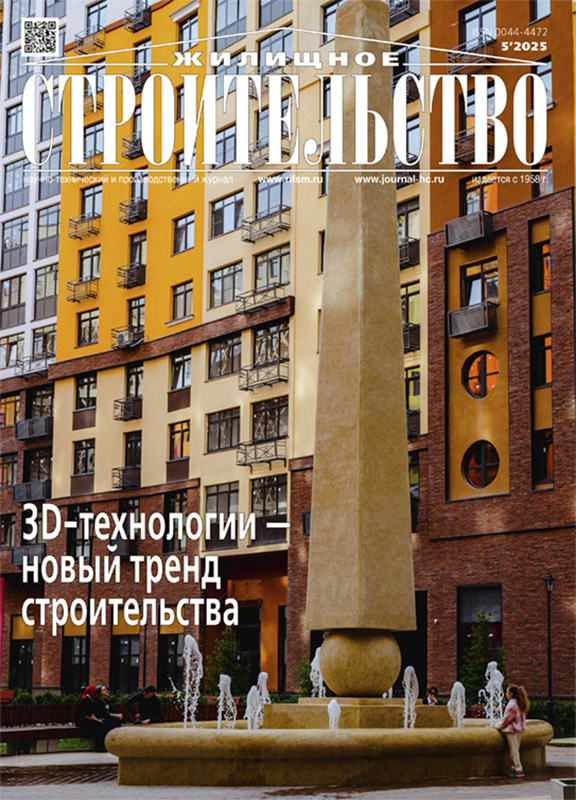The Method of the Overlap Device for Buildings Erected Using a 3D Printer
- Авторлар: Dmitriev A.V.1, Razov I.O.1
-
Мекемелер:
- Tyumen Industrial University
- Шығарылым: № 5 (2025)
- Беттер: 12-19
- Бөлім: Articles
- URL: https://transsyst.ru/0044-4472/article/view/684322
- DOI: https://doi.org/10.31659/0044-4472-2025-5-12-19
- ID: 684322
Дәйексөз келтіру
Аннотация
When constructing buildings by the method of layer-by-layer printing for wall construction, the technological process usually does not raise questions, the same cannot be said about the construction of an overlap or other horizontal bearing element. Basically, horizontal load-bearing elements are being tried to be erected in the traditional way using formwork. As part of the implementation of the state task, a new approach has been proposed for the installation of floors made of mortar mixtures. It is proposed to use the mortar mixture for 3D printing of the overlap with partial replacement of the cement binder with aleuropelite with simultaneous use of a viscosity modifier in the form of methocoline. For the construction of low-rise buildings, a 3D printer has been selected of a portal type, the design of which provides for the presence of a “mortar extruder” with 3 nozzles feeding the mortar mixture. Behind the “mortar extruder” there is a “reinforcement extruder”, whose stepper motors supply reinforcement wire from the coil to reinforce the structure. It is proposed to divide the overlap disk into so-called “rotary segments”, which are printed on a turntable provided in the design of the printer itself. The segment is printed in a horizontal position, and when the required strength is reached, it is installed in the design position using the same turning pad. The weight of the overlap segments in this case does not exceed 400 kg (with spans up to 5 meters), therefore it does not require additional lifting and transport mechanisms. After the formation of the overlap disk from the “turning segments”, the upper seams between them are caulked with a mortar mixture, combining the structure into a single whole.
Толық мәтін
Авторлар туралы
A. Dmitriev
Tyumen Industrial University
Хат алмасуға жауапты Автор.
Email: dmitrievav@tyuiu.ru
Candidate of Sciences (Engineering)
Ресей, 38, Volodarsky St., Tyumen, 625000I. Razov
Tyumen Industrial University
Email: dmitrievav@tyuiu.ru
Candidate of Sciences (Engineering)
Ресей, 38, Volodarsky St., Tyumen, 625000Әдебиет тізімі
- Fayzollin M.M., Chernavin V.Yu. Additive technologies for manufacturing floor slabs of large-panel buildings in civil engineering. Nauchnye Gorizonty. 2022. No. 5 (57), pp. 80–86. (In Russian). EDN: TVGXAG
- Dmitriev A.V. The effect of a crane load on a floor slab made using a 3D printer. Zhilishchnoe Stroitel’stvo [Housing Construction]. 2024. No. 3. pp. 3–7. (In Russian). EDN: NHHDYJ. https://doi.org/10.31659/0044-4472-2024-3-3-7
- Anton A., Jipa A., Reiter L., Dillenburger B. Fast complexity: additive manufacturing for prefabricated concrete slabs. RILEM International Conference on Concrete and Digital Fabrication. DC 2020: Second RILEM International Conference on Concrete and Digital Fabrication. 2020. Vol. 28, pp. 1067–1077. https://doi.org/10.1007/978-3-030-49916-7_102
- Razov I.O., Sokolov V.G. Dmitriev A.V., Erenchinov S.A. Proposal for the installation of overlap in the construction of buildings using additive technologies. Stroitel’nye Materialy [Construction Materials]. 2023. No. 10, pp. 116–120. (In Russian). EDN: LMBOKS. https://doi.org/10.31659/0585-430X-2023-818-10-116-120
- Slavcheva G.S., Solonina V.A., Panchenko Yu.F. The influence of filler characteristics on the technological properties of mixtures for construction 3D printing. Izvestiya of Higher Educational Institutions. Construction. 2023. No. 12 (780), pp. 37–51. (In Russian). EDN: YSHPRQ. https://doi.org/10.32683/0536-1052-2023-780-12-37-51
- Slavcheva G.S., Razov I.O., Solonina V.A., Panchenko Yu.F. Justification of the criteria requirements for fillers in mixtures for 3D construction printing. Nanotechnologies in Сonstruction. 2023. 15 (4), pp. 310–318. EDN: IFTQOV. https://doi.org/10.15828/2075-8545-2023-15-4-310-318
- Slavcheva G., Solonina V., Panchenko Y., Orlov V., Filipenko P., Effect of aleuropelite content on fresh and hardened properties of 3D-printable multi-binder composites. Construction of Unique Buildings and Structures. 2023. Vol. 109. No. 10909. EDN: CFYFKU. https://doi.org/10.4123/CUBS.109.9
- Dmitriev A.V., Sokolov V.G., Razov I.O. Reinforcement of walls and ceilings in the construction of buildings using additive technologies. Stroitel’naya Mexanika i Raschet Sooruzheniy. 2023. No. 6 (311), pp. 74–80. (In Russian). EDN: VNAVOV. https://doi.org/10.37538/0039-2383.2023.6.74.80
- Breseghello L., Naboni R. Toolpath-based design for 3D concrete printing of carbon-efficient architectural structures. Additive Manufacturing. 2022. Vol. 56. 102872. https://doi.org/10.1016/j.addma.2022.102872
- Veloso D., de Carvalho F., José M. Design and construction of 3d printer structure and production of mortar structural elements. Revista IBRACON de Estruturas e Materiais. 2022.
- Lapina A.I. Automation of optimal design of ceilings of monolithic frame buildings. Theory and practice of research and design in construction using computeraided design (CAD) systems: collection of articles of the III International Scientific and Technical Conference. Brest: BrSTU. 2019, pp. 47–54. (In Russian).
- Zhukyan P.P. Calculation of reinforced concrete slabs supported by contour. Vestnik of the Polotsk State University. Ser. F. Construction. Applied Science. 2014. No. 8, pp. 54–58. (In Russian). EDN: TPKRCB
- Popov A.N., Khatuntsev A.A., Shashkov I.G., Kochetkov A.V. Spatial deformation nonlinear calculation of reinforced concrete bendable structures by the finite element method. Internet-zhurnal Naukovedenie. 2013. No. 5 (18), p. 105. (In Russian). EDN: RXOXYX
Қосымша файлдар















